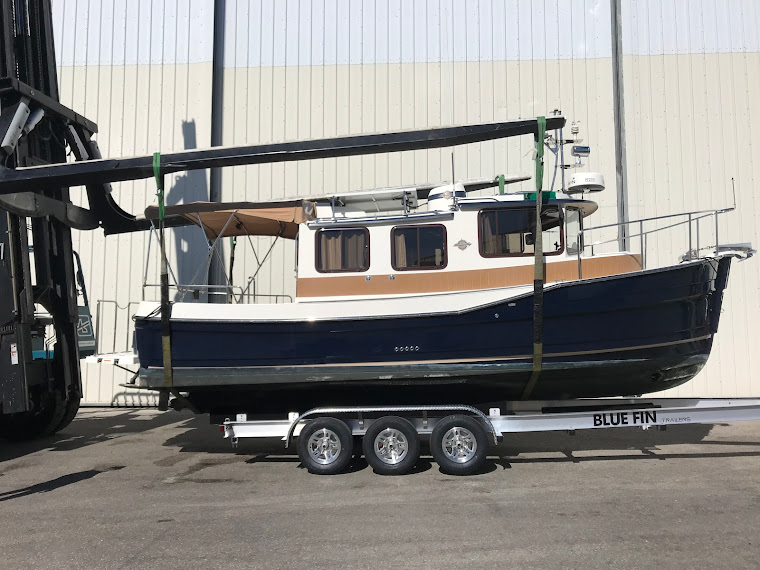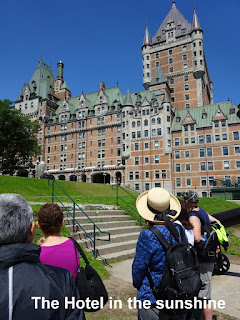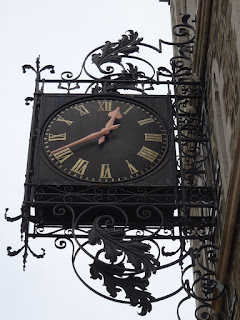The
many reasons this walled city is a worthy UNESCO World Heritage site are
immediately apparent. From our dock in
the inner harbor behind a tidal lock we had a premier view of the city-scape
that has won recognition for this unique and historic Canadian city.
Back in
the 1970s clever leaders began to revive the historic center of this town and
today we can enjoy the results of the extensive preservation. A walk in the
upper and lower old town areas is a stroll into previous centuries. As we learned on our walking tour, the core
has preserved buildings from the three major periods of Quebec – the French,
the British, and the early Confederation periods. Geography was important in
the selection of this site for an early settlement by Samuel de Champlain in 1608
– the site is at the narrowest portion of the St Lawrence River and blessed
with a cliff offering protection and a strategic vantage point. Initially the commercial town was on the
lower level and the government, military and church occupied and controlled the
upper level. But today it is clear that
merchants as well as governors eventually occupied the heights. Many of the winding streets inside the
ramparts are still paved with cobble stones.
Only a few modifications have been made to the walls as concessions to
modern vehicles and desire for a view.
Our guide told us that the credit for realizing the potential of these
massive structures and the character of this old city go to Mr. Dufferin who
had visited Carcassonne in France. He
envisioned one day that this city would also reap the benefits of preserving its
massive architecture. We walked the promenade named after him with fondness for
his memory and gratitude for his foresight.
One
of our favorite stories is the match making skills of the Ursine Sisters who
came in the early 1600s to educate girls.
They also served as match makers for the French girls called the King’s
daughters because the King paid their dowry.
These gals came to marry the many eligible male inhabitants. The nuns were so successful that 70% of
Quebecers trace their ancestry to the 600+ matches they made.
Although
the UNESCO team probably enjoyed numerous meals in Quebec City, the many
outstanding restaurants were not a factor in their award. We, on the other hand, managed to sample as
many of the eateries as we could stuff into our stay. On the rainy days we ate inside – stumbling
on the oldest café in the city where we enjoyed lunch and dried off. Other delightful meals were taken outdoor
cafes which dot both the upper and lower city sidewalks. We also frequented the
market adjacent to the harbor. Their
local treats and delicacies made for excellent snacks between meals.
All
the eating was balanced by the walking, and it is somewhat justified by the
steep climbs which are part of Quebec’s charm. Several times a day we either
climbed stairs or steep streets from our dock in the lower city to the sites
above.
Then to cap off our visit we
toured the Citadel on the highest point of the city. This fort built by the
British reminded us of the one we visited in Kingston ON last year. Both were built after the War of 1812 as
protection against a possible American invasion. Earlier fortifications on the site did not
make it impregnable. Although we Americans failed twice in our attempts to conquer
this territory, the British managed to defeat the French in the famous battle
on the Plains of Abraham in 23 minutes. Thus French speaking Quebec has been a
part of the British tradition ever since.
This mixture has some interesting side notes like the monument to the
battle that commemorates BOTH the winning and losing commanders. Also the changing of the guard ceremony at
the Citadel is modeled after the one at Buckingham Palace with the same striking
uniforms…only here the entire performance is conducted with French commands. Since
Canada is a bilingual country, they kindly also explained the proceedings in
English as well. Our guided tour was
also in English by the lively Frank the Tank who marched us around the grounds
while leaping from wall to cannon. He
showed us the highest point on Cap Diamont and the spectacular views over the
Plains of Abraham, the St Lawrence River, and the city below. We also passed
the base commander’s house where one member of the tour lived as a child when
his father served in this job. The several museums we visited are dedicated to
fort’s past and the Royal 22nd Regiment – the active military force stationed
here.
Such
a rich (on many levels) environment is difficult to leave – we feel fortunate
that even with a few rainy days we had almost a week to enjoy all the delights
of Quebec City.


































































































No comments:
Post a Comment